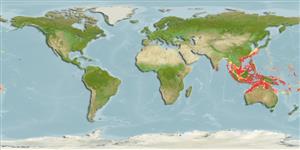Classification / Names
Common names from other countries
Main reference
Size / Weight / Age
Max length : 30.0 cm SL male/unsexed; (Ref. 48635)
Environment
Marine; reef-associated; oceanodromous (Ref. 51243); depth range 12 - 400 m (Ref. 90102)
Climate / Range
Subtropical, preferred 28°C (Ref. 107945); 32°N - 22°S
Distribution
Short description
Dorsal
spines
(total): 10;
Dorsal
soft rays
(total): 12-14;
Anal
spines: 3;
Anal
soft rays: 13 - 14. Medium-sized fish of moderately deep body. The eyes large; the mouth oblique, with the lower jaw projecting upwards. The body tapers very slightly to beneath the middle of the soft portion of the dorsal fin, and then abruptly to the peduncle. This species is distinguished from P. fitchi by the presence of numerous rusty brown to yellowish spots in the membranes of the dorsal and anal fins, and its less tapered body.
IUCN Red List Status (Ref. 115185)
Threat to humans
Harmless
Human uses
Fisheries: commercial
More information
Common namesSynonymsMetabolismPredatorsEcotoxicologyReproductionMaturitySpawningFecundityEggsEgg development
ReferencesAquacultureAquaculture profileStrainsGeneticsAllele frequenciesHeritabilityDiseasesProcessingMass conversion
Tools
Special reports
Download XML
Internet sources
Estimates of some properties based on models
Phylogenetic diversity index
PD50 = 0.5002 many relatives (e.g. carps) 0.5 - 2.0 few relatives (e.g. lungfishes)
Trophic Level
4.1 ±0.60 se; Based on food items.
Resilience
Medium, minimum population doubling time 1.4 - 4.4 years (K=0.7-1.0; tmax=6)
Vulnerability
Low vulnerability (17 of 100)
Price category
